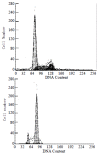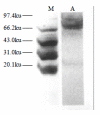Preparation of monoclonal antibody against apoptosis-associated antigens of hepatoma cells by subtractive immunization
- PMID: 12378620
- PMCID: PMC4656566
- DOI: 10.3748/wjg.v8.i5.808
Preparation of monoclonal antibody against apoptosis-associated antigens of hepatoma cells by subtractive immunization
Abstract
Aim: To elucidate the expression of the apoptosis-associated molecules in human primary hepatocellular carcinoma (HCC) cells, and prepare the monoclonal antibodies (mAb) against the apoptosis-associated antigens of HCC cells.
Methods: Human HCC cell line HCC-9204 cells were induced apoptosis with 60 mL x L(-1) ethanol for 6 h and their morphological changes were observed by transmission electron microscope. The cell DNA fragmentations were detected by Terminal Deoxynucleotidyl transferase-mediated dUTP nick end labeling (TUNEL) assay, and the cell DNA contents by flow cytometry. Ten mice were immunized with ethanol-induced apoptotic HCC-9204 cells with the method of subtractive immunization, while the other 10 mice used as the control were immunized by the routine procedures. The tail blood of all the mice were prepared after the last immunization, and the produced antibodies were determined by the immunocytochemical ABC staining. The splenic cells of the mice whose tail blood sera-HCC-9204 cells serum reactions were most different between the apoptotic and the non-apoptotic were prepared and fused with the mouse myeloma cell line SP2/0 cells. The positive antibodies were selected by ELISA assay. The fusion rates of hybridoma cells and the producing rates of antibodies were calculated. The fused cells that secreted candidate objective antibody were cloned continually with the of limited dilution method, and then selected and analyzed further by the immunocytochemical ABC staining. The chromosomes of the cloned hybridoma cells that secreted objective mAb and the mAb immunoglobulin (Ig) subtype of the prepared mAb were also determined. The molecular mass of the mAb associated antigen was analyzed by Western blot assay.
Results: HCC-9204 cells treated with 60 mL x L(-1) ethanol for 6 h, manifested obvious apoptotic morphological changes, the majority of the cells were TUNEL-positive, and the sub-G1 apoptotic peak was evident. There were 2 mice in the experimental group whose tail blood serum reacted strongly with the apoptotic HCC-9204 cells, but weakly with their non-apoptotic counterparts. In the fusion rates of hybridoma cells as well as the producing rates of the antibody described above, there did not show significant difference between the experimental and the control group, but weakly with non-apoptotic HCC-9204. However, the total producing rate of antibodies in the experimental group was significantly lower compared with the control (P<0.01), and so was the producing rate of the antibodies which reacted strongly with both apoptotic and non-apoptotic HCC-9204 cells(P<0.01). After cloned continually for several times the cell that produce mAb which reacted strongly with the nuclei of ethanol-induced apoptotic HCC-9204 cells, but very weakly with that of non-apoptotic cells was selected out. Chromosome analysis revealed that the selected cell was with the universal characteristics of the monoclonal hybridoma cells which secreted mAb, and the Ig subtype of the prepared mAb was IgG1. The molecular mass of this mAb associated antigen of was about 75 ku.
Conclusion: Subtractive immunization is a useful method to prepare the mAb against the apoptosis-associated antigens of cells. The expression of some molecules increases to some extent in HCC-9204 cells in the process of apoptosis induced by low-concentration ethanol. The mAb that may be against ethanol-induced apoptosis-associated antigens of HCC cells was successfully prepared and primarily identified.
Figures







References
-
- Hengartner MO. The biochemistry of apoptosis. Nature. 2000;407:770–776. - PubMed
-
- Simon HU. Regulation of eosinophil and neutrophil apoptosis--similarities and differences. Immunol Rev. 2001;179:156–162. - PubMed
-
- Holtzman MJ, Green JM, Jayaraman S, Arch RH. Regulation of T cell apoptosis. Apoptosis. 2000;5:459–471. - PubMed
Publication types
MeSH terms
Substances
LinkOut - more resources
Full Text Sources
Medical

